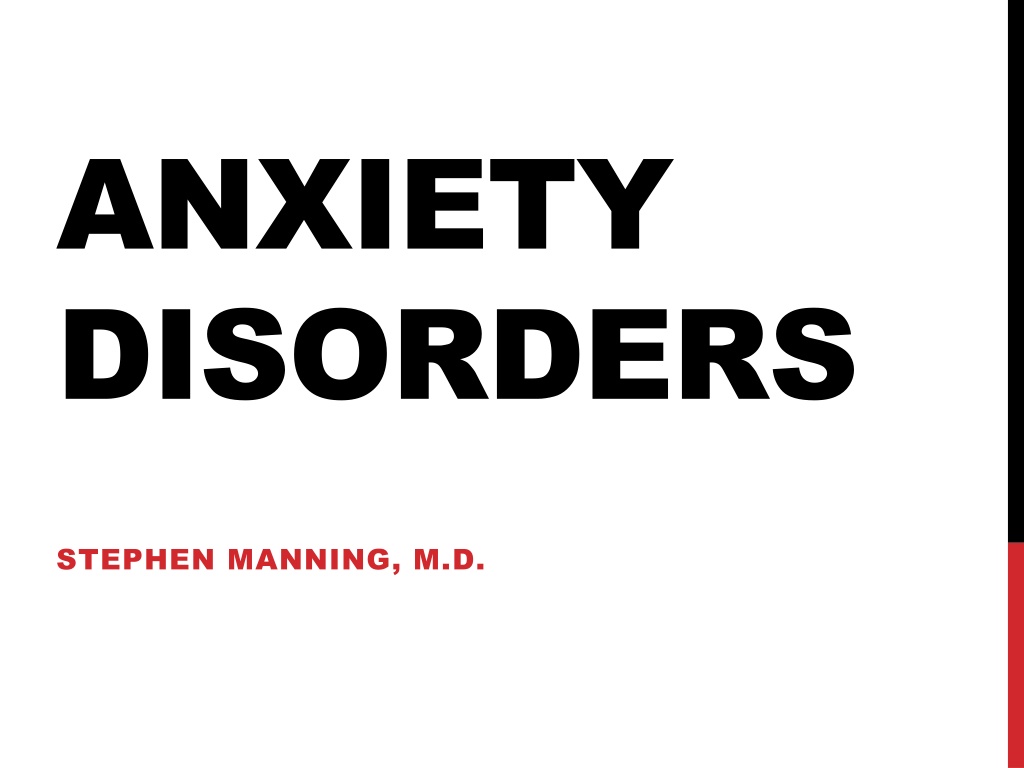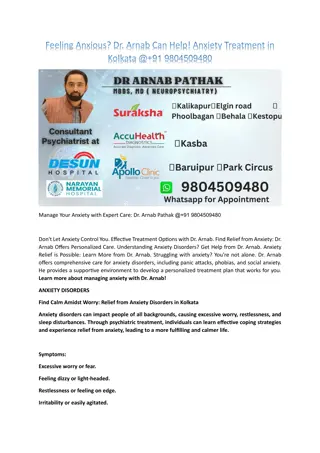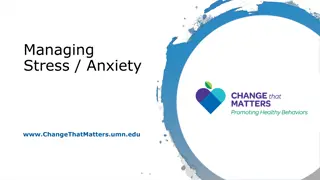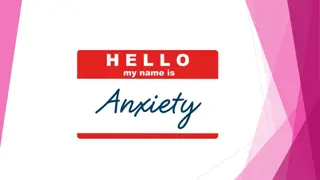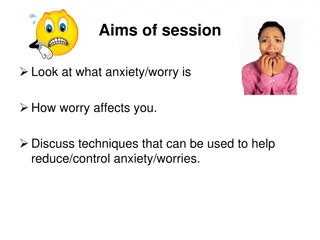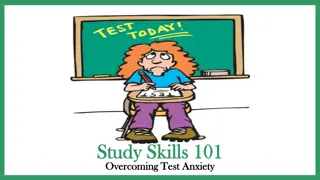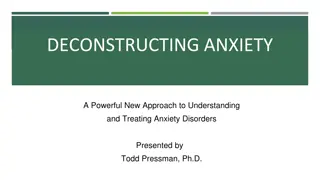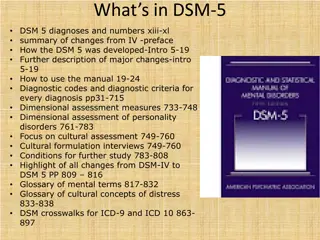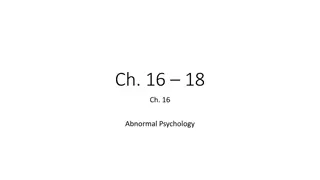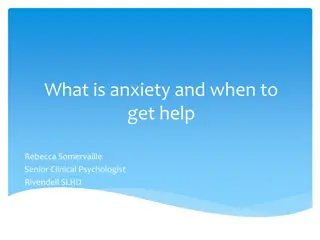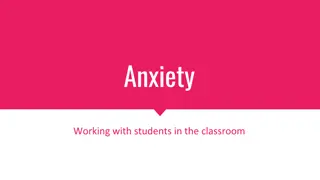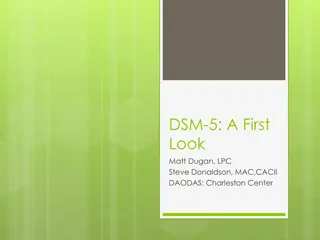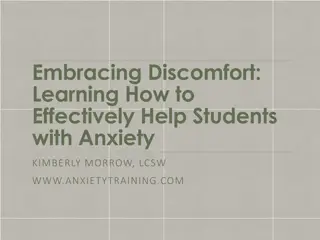Understanding Anxiety Disorders in DSM-5
Anxiety disorders encompass a range of conditions, from separation anxiety to social phobia and generalized anxiety disorder. The DSM-5 has re-conceptualized these disorders, grouping OCD in its own category and moving PTSD to trauma-related disorders. Recognizing symptoms and seeking appropriate treatment are crucial in managing these prevalent psychiatric conditions.
Download Presentation

Please find below an Image/Link to download the presentation.
The content on the website is provided AS IS for your information and personal use only. It may not be sold, licensed, or shared on other websites without obtaining consent from the author. Download presentation by click this link. If you encounter any issues during the download, it is possible that the publisher has removed the file from their server.
E N D
Presentation Transcript
ANXIETY DISORDERS STEPHEN MANNING, M.D.
ANXIETY DISORDERS Among the most prevalent of psychiatric conditions Fear or apprehension that is out of proportion to the situation and with functional impairment Variously referred to over time soldier s heart , effort syndrome, neurocirculatory asthenia Freud recognized early trauma could express in anxious symptoms and behaviors
ANXIETY DISORDERS DSM-5 has re-conceptualized the anxiety disorders as different in some respects from DSM-4 TR Obsessive-compulsive disorder, previously in the anxiety disorders in DSM-4 TR, is now grouped in its own category along with body dysmorphic disorder, hoarding disorder, trichotillomania, and excoriation disorder. The obsessive-compulsive category can also have disorders related to medical conditions and substance abuse.
ANXIETY DISORDERS Post traumatic stress disorder and acute stress disorder have been moved from anxiety disorders in DSM-4TR to trauma and stressor related disorders as part of DSM-5 Scientific data has shown that these disorders stand apart from the other anxiety disorders
DSM-5 ANXIETY DISORDERS Separation anxiety disorder Selective mutism Specific phobia Social anxiety disorder ( also known as social phobia) Panic disorder
DSM-5 ANXIETY DISORDERS Agoraphobia Generalized anxiety disorder Substance/ medication- induced anxiety disorder Anxiety disorder due to another medical condition Other specified anxiety disorders and unspecified anxiety disorders
SEPERATION ANXIETY DISORDER Excessive anxiety regarding separation from places or people to whom the patient has a strong emotional attachment 12 month prevalence in childhood is 4% and in adults 1 - 2% Onset of the disorder in childhood usually does not progress into adulthood and the attachment is usually to a parent
SEPARATION ANXIETY DISORDER The majority of adults have the onset of their symptoms in adulthood with the attachment to a spouse or friend The symptoms must be present for at least four weeks in children but six months or more in adults. Three types of distress or worry may occur and include distress when anticipating or experiencing separation from home or other major figures
SEPARATION ANXIETY DISORDER Excessive worry about an event that causes separation Reluctance to go out from home because of fear of separation Fear of being alone or without attachment figures Reluctance to sleep away from home Repeated nightmares with the theme of separation
SEPARATION ANXIETY DISORDER Complaints of physical symptoms when separated The symptoms cause clinically significant distress or impairment in areas of function Not better accounted for by another mental disorder
SEPARATION ANXIETY DISORDER TREATMENT Medication in combination with individual psychotherapy and potentially family therapy SSRIs, benzodiazepines Cognitive behavioral therapy, social skills training, graded exposure and relaxation training
SELECTIVE MUTISM Persistent failure to speak in specific social situations Uncommon but usually in younger children Do not initiate speech or respond reciprocally in social situations Not diagnosed unless it goes on longer than one month This is not related to poor familiarity with the language
SELECTIVE MUTISM Only diagnosed when a child has an established capacity to speak in some social situations Specific criteria include: Failure to speak in specific social situations in which it is expected
SELECTIVE MUTISM Duration of one month not limited to the first month of school Not attributable to lack of knowledge or comfort with the language Not better explained by a communication disorder or during the course of autism spectrum disorder, schizophrenia or other psychosis s
SELECTIVE MUTISM TREATMENT Difficult Use SSRIs Behavioral techniques Parental counseling
SPECIFIC PHOBIAS AND SOCIAL ANXIETY DISORDER Phobias are irrational fears of specific objects, places or situations, or activities Social anxiety disorder or social phobia is the fear of humiliation or embarrassment in social situations Specific phobias include isolated phobias such as the intense and irrational fear of snakes
DSM-5 CRITERIA SPECIFIC PHOBIA Marked fear or anxiety about a specific object or situation i.e. flying, heights, animals, seeing blood mixed. The phobic object or situation almost always provokes immediate fear or anxiety The phobic object is actively avoided or endured with intense fear or anxiety
DSM-5 SPECIFIC PHOBIA The fear or anxiety is out of proportion to the actual danger Fear or avoidance is persistent typically lasting six months or more Fear, anxiety and avoidance causes functional impairment Symptoms are not better accounted for by other diagnoses
DSM-5 CRITERIA SOCIAL PHOBIA Marked fear or anxiety about one or more social situations in which exposure to possibly scrutiny of others Fear that one will act in a way or show anxiety that will be negatively evaluated Social situations almost always provoke fear or anxiety The social situations are avoided or endured with intense fear or anxiety
DSM-5 CRITERIA SOCIAL PHOBIA The fear or anxiety is out of proportion to the actual threat posed by the situation Fear, anxiety, or avoidance typically last for six months or more The symptoms cause clinically significant distress or impairment The symptoms are not attributable to a substance or medical condition
DSM-5 CRITERIA SOCIAL PHOBIA Symptoms are not better explained by another mental disorder If another medical condition is present the symptoms are unrelated
EPIDEMIOLOGY, CLINICAL FINDINGS AND COURSE The most commonly feared objects or situations as part of specific phobias include animals, storms, heights, illness, injury, and death Very few persons (2-3%) who are phobic seek treatment due to their ability to avoid the objects of their fears When phobic individuals are exposed to feared objects physical symptoms are typical as are fearful thoughts
EPIDEMIOLOGY, CLINICAL FINDINGS AND COURSE National Comorbidity Survey reveals 11% prevalence rates for specific phobias and 13% for social phobia Specific phobias are more common in women Social phobias appear equally in men and women Specific phobias typically start before age 12 Social phobias typically in adolescence before age 25
EPIDEMIOLOGY, CLINICAL FINDINGS AND COURSE Typically the symptoms of social anxiety develop slowly and it becomes chronic About one in eight persons with social anxiety develops a substance use disorder and 50% meet criteria for another psychiatric disorder such as major depression Social phobias tend to subside as a person ages
ETIOLOGY AND PATHOPHYSIOLOGY Phobic disorders tend to run in families Breed true Some suggestion that dopaminergic pathways play a role in social anxiety disorder. Functional brain studies have found decreased striatal dopamine D2 receptor and transporter binding in social anxiety disorder Learning may play an important role in the etiology of phobias with trauma induction
DIFFERENTIAL DIAGNOSIS Must rule out other anxiety disorders Must differentiate irrational fears from delusions and the psychotic patient People with avoidant personality disorder feel insecure about social relationship and fear being hurt by others Schizoid personality disorders have little interest in social relationships
MEDICATION MANAGEMENT Fluoxetine, Paroxetine, Sertraline, and long-acting Venlafaxine are all approved by the FDA for the treatment of social anxiety Other SSRIs, MAOIs and benzodiazepines are probably effective for social anxiety. Tricyclic antidepressants are probably less effective Medications are generally ineffective for the treatment of specific phobias. Benzodiazepines may provide temporary relief but have risk of abuse and dependence
PSYCHOLOGICAL TREATMENTS Behavior therapy can be very effective for social anxiety and specific phobias and involves exposure through systematic desensitization and flooding Cognitive behavioral therapy can be used to correct dysfunctional thoughts about fear
PANIC DISORDER Consists of recurrent, unexpected panic attacks Accompanied by at least one month of persistent concern about having another attack, worry about the implications of having an attack or maladaptive change in behavior related to the attacks At least four of 13 characteristic symptoms must occur The attacks are not related to substance or medical condition or better accounted for by another mental disorder
DSM-5 CRITERIA FOR PANIC ATTACK Panic attacks are not a mental disorder Panic attacks can occur in the context of any anxiety disorder or other mental disorder and some medical conditions An abrupt surge of intense fear or intense discomfort that reaches a peak within minutes and which 4 or more of the following symptoms occur: Palpitations
PANIC ATTACK CRITERIA Sweating Trembling or shaking Shortness of breath or smothering Feelings of choking Chest pain or discomfort Nausea or abdominal distress Feeling dizzy, unsteady, lightheaded, or faint Chills or heat sensations Paresthesias such as numbness or tingling Derealization or depersonalization Fear of losing control or going crazy Fear of dying
DSM-5 CRITERIA FOR PANIC DISORDER Recurrent unexpected panic attacks At least one attack has been followed by one month or more of either persistent concern or worry of another attack or a maladaptive change in behavior to avoid having an attack The symptoms are not attributable to substances or medical conditions Symptoms are not better explained by another mental disorder
EPIDEMIOLOGY, CLINICAL FINDINGS, COURSE The national comorbidity survey reports 5% of women and 2% of men have met criteria for panic disorder at some point in their life The rate of panic disorder is elevated threefold in primary care patients and hiring specialty clinics Typical onset in the mid-20s; eight out of 10 patients develop the disorder before the age of 30 No clear precipitating stressors have been identified
EPIDEMIOLOGY, CLINICAL FINDINGS, COURSE The initial attack is alarming and may prompt a visit to the emergency department Many times unnecessary medical workups are performed with specialist referrals Typically the symptoms develop suddenly, peak within 10 minutes and resolve in 5 to 20 minutes Panic disorder is often a chronic course with fluctuation in symptoms
EPIDEMIOLOGY, CLINICAL FINDINGS, COURSE 70% of patients will have some degree of improvement with treatment An increased risk of suicide due to co-occurring depression and substance misuse A number of physical conditions have been found in patients with panic disorder in the realm of connective tissue, pain perception and autoimmune abnormalities The most common comorbid psychiatric conditions are major depression and alcohol/drug use disorder (20%)
ETIOLOGY AND PATHOPHYSIOLOGY Family studies report the morbidity risk for the disorder is nearly 20% among first-degree relatives Twin studies report higher rates in identical versus nonidentical twins Biological mechanisms may involve several neurotransmitter systems Several theories relate to different substances that may induce panic i.e. hyper sensitivity to CO2
ETIOLOGY AND PATHOPHYSIOLOGY Psychoanalytic theory postulates that repression as a defense to unacceptable thoughts and conflict become conscious in a disguised form Behaviorist argue that this is a conditioned response to a fearful situation
DIFFERENTIAL DIAGNOSIS Hyperthyroidism Pheochromocytoma Hypoglycemia Supraventricular tachycardia Major depressive disorder Generalized anxiety disorder Schizophrenia Depersonalization disorder Somatization disorder Borderline personality disorder ..only to name a few
CLINICAL MANAGEMENT Usually a combination of medication and individual psychotherapy SSRIs are the medications of choice and are effective in 70 to 80% of patients. Typically start low and go slow. The FDA has approved fluoxetine, paroxetine, sertraline and long-acting venlafaxine for the treatment of panic disorder SSRIs/SNRIs have superseded tricyclic antidepressants and monoamine oxidase inhibitors due to side effects
CLINICAL MANAGEMENT Benzodiazepines can be helpful in the short term but have the risk of dependence and tolerance Positive factors for response to treatment include milder anxiety, later age of onset, fewer panic attacks, and a relatively normal personality Should encourage to limit stimulants including caffeine Cognitive behavioral therapy is a benefit
AGORAPHOBIA A condition in which an individual fears being unable to get out of a place or situation quickly in the event of a panic attack As a consequence of the patient s fear they avoid places or situations in which they believe that this might occur It is often, but not always, a complication of panic disorder It is nearly as common as panic disorder with women more likely than men to suffer from it
AGORAPHOBIA The true fear is being separated from a source of security As is common in anxiety states, avoidance of places or situations that the patient believes exacerbate their symptoms is typical Often being accompanied and reassured by a significant other is quite helpful
DSM-5 CRITERIA FOR AGORAPHOBIA Fear or anxiety about two or more of the following: using public transportation being in open spaces being in enclosed places standing in line or being in a crowd being outside of the home alone Avoidance of these situations for fear that escape might be difficult or that help may not be available
DSM-5 CRITERIA FOR AGORAPHOBIA The situations almost always provoke fear or anxiety Situations are actively avoided, require a companion, or endured with intense fear or anxiety The fear or anxiety is out of proportion to the actual danger The fear, anxiety or avoidance is persistent for at least six months
DSM-5 CRITERIA FOR AGORAPHOBIA The symptoms cause clinically significant distress and impairment of functioning Not related to another medical condition Not better explained by the symptoms of another mental disorder
GENERALIZED ANXIETY DISORDER Patients worry excessively about life circumstances as the central feature The patient will often have symptoms of restlessness or being keyed up, easily fatigued, difficulty concentrating, irritability, muscle tension, or poor sleep Symptoms are present more days than not and cause distress and impairment
DSM-5 CRITERIA FOR GENERALIZED ANXIETY DISORDER Excessive anxiety and worry more days than not for at least six months The individual finds it hard to control the worry The anxiety and worry are associated with three or more of the following symptoms most days over six months: restlessness or feeling keyed up easily fatigued difficulty concentrating
DSM-5 CRITERIA FOR GENERALIZED ANXIETY DISORDER irritability muscle tension sleep disturbance The symptoms cause significant distress or impairment in functioning Symptoms not attributable to the effects of a substance or another medical condition Not better explained by another mental disorder
ETIOLOGY AND PATHOPHYSIOLOGY It runs in families as supported by twin studies There are genetic as well as nongenetic factors that are important Neurotransmitter systems probably involved include norepinephrine, GABA, and serotonin systems in the frontal lobe and limbic system
DIFFERENTIAL DIAGNOSES Rule out substance induced including: Caffeine intoxication Stimulant abuse Alcohol, benzodiazepine and sedative- hypnotic withdrawal
